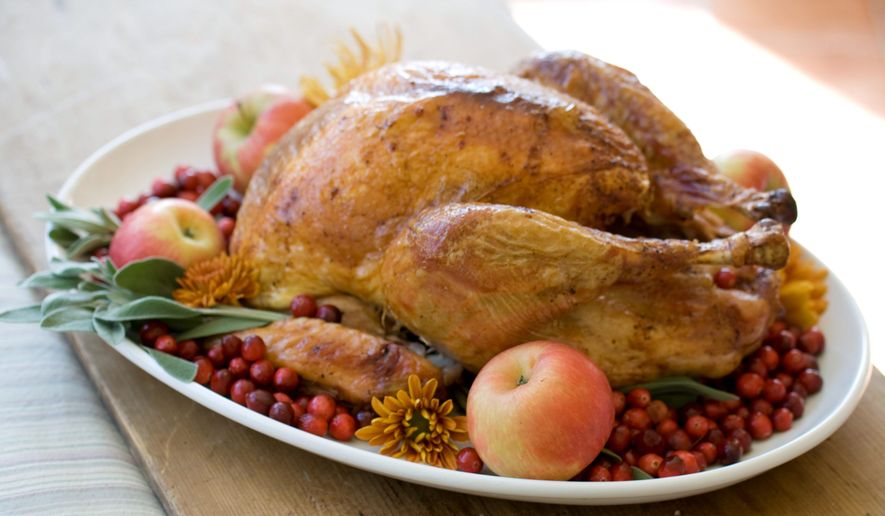The moment Thanksgiving diners walk in to Indigo on K Street NE, both the American and Indian cultures will be readily apparent.
The restaurant’s wooden floor, tables and sign advertising alcohol sales make the restaurant resemble a local burger joint more than an Indian restaurant. Writing, mainly in English, covers every wall from floor to ceiling. But the menu, written on a chalkboard, is filled with both traditional and untraditional Indian food and drinks, while the television blares Bollywood pop music to greet the thousands of customers who have walked through its doors since the restaurant opened in 2013.
That mix of American and Indian culture is something that carries over to Thursday’s quintessentially American holiday for Dinesh Tandon, the owner of the Indian restaurant, his family and Indian-American immigrants across the U.S.
“I believe that a person who does not keep in touch with his roots is a lost person,” Mr. Tandon said. “I wanted my kids to be connected to their roots as well as be accustomed to the American culture in which they grew up.”
Thanksgiving provides a unique opportunity for the roughly 40 million immigrants who now call America home to celebrate the U.S., but many have their own twists on the day.
Different ethnic traditions surrounding Thanksgiving are almost as old as the holiday itself. Deeply influenced by Native American and Hispanic culture, repasts in the American Southwest may include turkey rubbed in ancho chile paste and cumin, served with cornbread and sweet potatoes instilled with green chiles and chipotle peppers. Pumpkin flan stands in for pumpkin pie.
PHOTOS: Best handguns ever made
Polish cooks complement the main turkey course with pumpkin soup with potato dumplings, while an Italian-tinged Thanksgiving meal may feature seafood bruschetta on the side. Ethiopian-Americans, many of whom are beginning their annual 30-day pre-Christmas fast, might include misir wat, a lentil-based stew, with their turkey and trimmings.
Mr. Tandon, his wife and three children celebrate the traditional holiday in a traditional American way — filled with turkey, pumpkin pie and other American staples. However, there will be variations that align with other Indian traditions. The family shares gifts and prepares some of their favorite Indian food they don’t usually have the rest of the year.
Admittedly, the three kids are “blended in” to the American culture after having lived in the U.S. for much of their lives, Mr. Tandon said.
For others, the holiday season is used as an excuse to see family as well as give thanks, said Sarah Samaha, a senior at American University and member of the D.C. school’s Arab Student Association.
“It can be hard” living so far away from family, said Ms. Samaha, who is originally from Lebanon.
Although she moved to the U.S. when she was 2 years old, a lot of her family did not make the move. Thanksgiving allows her to see her aunt and two cousins who live in the U.S., but the thankfulness surrounding the holiday extends deeper.
PHOTOS: See Obama's biggest White House fails
“A big part of why we do Thanksgiving is to show how thankful we are that this country exists,” Ms. Samaha said. “It gave us so much. It gave my parents the opportunity to escape the chaos that is their home country. It gave us a chance to escape and find a new life where we didn’t have to duck under a table in fear or go to a bomb shelter.”
Rebecca Karam, another member of the Arab Student Association at American University, said Thanksgiving is a chance for immigrants to show appreciation to America and the freedom it offers.
Like Mr. Tandon, both Ms. Samaha and Ms. Karam mix their turkey and stuffing with dishes that highlight their non-American roots. Cecilia Hae-Jin Lee, author of the Korean cookbook “Eating Korean,” who now resides in California, does the same.
Ms. Lee moved to the U.S. as a little girl in 1977 but has kept in touch with her Korean roots.
“When immigrants come to America, everyone wants to assimilate to the American culture but also maintain part of their identity. As much as we like America, there are things we like about our original culture as well,” Ms. Lee said.
Even those from the U.S. can have vastly different traditions.
Hawaiians use Thanksgiving as a time to celebrate the “mainland” traditions, said Mikala Brennan, a Hawaiian native who now owns the Hula Girl Truck in Washington. Hawaii’s culture vastly differs from the continental U.S., but the large military population in the state is a factor in keeping the importance of the holiday intact, Ms. Brennan said.
Ms. Brennan will serve turkey to her family with a traditional plate of rice reflecting its importance in Hawaiian family meals. She added that char sui or Chinese sausage could also be added to the fried rice to boost the flavor.
Few understand the importance of giving thanks more than those who immigrated in search of a better life and the freedom the U.S. provides.
“I try to keep [my children] connected with their culture. Initially it was tough, but now we are used to it,” Mr. Tandon said. “We are pretty blended in. Now we have two places to call home.”
• Mark Pace can be reached at mpace@washingtontimes.com.




Please read our comment policy before commenting.